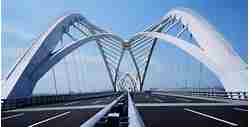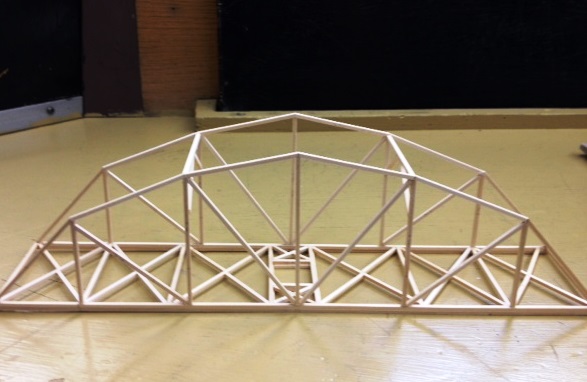Courses by Software
Courses by Semester
Courses by Domain
Tool-focused Courses
Machine learning
POPULAR COURSES
Success Stories
Understanding the concepts on Degrees of Freedom
AIM - Question 1: A five storey structure with 5 translational DOF is shown here. Each storey has mass ‘m’. The eigenvalue problem has been solved and the 5 periods of vibration Tn and their corresponding mode shapes, φn has been derived. ANS - MASS MATRIX (m) = …
Harshal virkhare
updated on 19 Jul 2022
AIM -
Question 1:
A five storey structure with 5 translational DOF is shown here. Each storey has mass ‘m’. The eigenvalue problem has been solved and the 5 periods of vibration Tn and their corresponding mode shapes, φn has been derived.
ANS - MASS MATRIX (m) =
[m00000m00000m00000m00000m]
modified Mass matrix (M) = ϕnt.m.ϕn
for the first mode = [0.334,0.641,0.895,1.078,1.173][m00000m00000m00000m00000m]`[0.3340.6418951.0731.178]
(n=1)
M1=3.861m
MODEL PROPERTY (L) = ϕnT..m.t
Where(t) = infiluence vector (assuming 100% utilization of seismic force ) = [11111]`
For the first mode = [0.334 0.641 0.895 1.078 1.173] [m00000m00000m00000m00000m]`[11111]`
L1=4.121M
MODEL PARTICIPATION FACTOR ((Γ)=LM
FOR THE FIRST MODE Γ=L1M1
(n=1)
Γ=4.1213.861
simmilarly, Γ2=-0.335
Γ3=0.177
Γ4=-0.098
Γ5=0.045
Effective Model Mass (M*) =L2nMn
For the first mode M1 = L21Mn
(n=1)
M1*=(4.121m)23.861
M = 4.398m
M2=0.436m
M3=0.121m
M4=0.038m
M5=0.008M
MODEL MASS PARTICIPATION RATIO=MnMj
where mj=total mass of the building =m+m+m+m+m =5m
Modal mass participation ratio of first mode (n=1)=4.398m/5m=.88
simillarly, Second Mode (n=2)=0.09
Third Mode (n=3) = 0.02
Fourth Mode (n=4) = 0.01
Fifth Mode (n=5) = 0.002
Adding First two Mode Mass Participation Ratios, We get 0.88+0.09=0.97
TO Achive Minimum 90% of model Mass Participation Ratio First Two Modes Are Enough.
BASE SHEAR (VB)=Mn.An
For The first mode VB1=4.398m*0.27g
(n=1)
VB1=1.187 mg
simmilarly, VB2=0.327mg
VB3=0.126mg
VB4=0.039mg
VB5=0.008mg
Average Base Shear is Calculated By the method of square root of Sum of Square
√(Vb12)+(Vb22)+(Vb32)+(Vb42)+(Vb52)
Vb=1.15mg
Γ=4.1213.861
simmilarly, Γ2=-0.335
Γ3=0.177
Γ4=-0.098
Γ5=0.045
Effective Model Mass (M*) =L2nMn
For the first mode M1 = L21Mn
(n=1)
M1*=(4.121m)23.861
Leave a comment
Thanks for choosing to leave a comment. Please keep in mind that all the comments are moderated as per our comment policy, and your email will not be published for privacy reasons. Please leave a personal & meaningful conversation.
Other comments...
Be the first to add a comment
Read more Projects by Harshal virkhare (63)
Project 2
1.Display the data of white wine and red wine. Ans: iam sending a bar chart for represnting data in graphical way 2.Get the size of both white wine and red wine. Ans: The white wine data size is more compared to red wine white wine --> 4899 rows red winr --> 1600 rows …
03 Feb 2024 04:26 AM IST
To Analysis and Design of Steel Structures using TSD
1. AIM: Summarize your study for the bending moment, shear force and deflection diagrams for the elements of the model PROCEDURE: Initally open the Tekla file you saved prviously After opening the file->We ste the Seismic data in the structure To set->go to Load panel->Under seismic load go to Seismic wizard Select the…
17 Jan 2024 02:38 AM IST
To calculate wind load for industrial steel structures and to apply it by using TSD
1) Aim - Generate manual wind loading in the design report based IS code as per the following input Basic wind speed = 39 m/s Terrain category = 2 Procedure - First calculate load combination Result - Calculations are done for the wall panel 2) Aim - Based on the above calculation apply the…
16 Jan 2024 06:49 PM IST
To calculate dead and live load for industrial steel structures and to apply them using TSD
1. AIM: Calculate dead load in design report based on IS code and apply dead load on the model Finishes of 50mm Slab as per design Brickwall 150mm thickness Roofing load based on purlin size Ceiling loading 0f 0.3KN per sq m PROCEDURE: Dead load calculations of the the structure as per the structures is given below…
16 Jan 2024 06:47 PM IST
Related Courses






0 Hours of Content

Skill-Lync offers industry relevant advanced engineering courses for engineering students by partnering with industry experts.
Our Company
4th Floor, BLOCK-B, Velachery - Tambaram Main Rd, Ram Nagar South, Madipakkam, Chennai, Tamil Nadu 600042.
Top Individual Courses
Top PG Programs
Skill-Lync Plus
Trending Blogs
© 2025 Skill-Lync Inc. All Rights Reserved.








